JAGUAR XJ 2004 X350 / 3.G Owners Manual
Manufacturer: JAGUAR, Model Year: 2004, Model line: XJ, Model: JAGUAR XJ 2004 X350 / 3.GPages: 227, PDF Size: 4.22 MB
Page 201 of 227
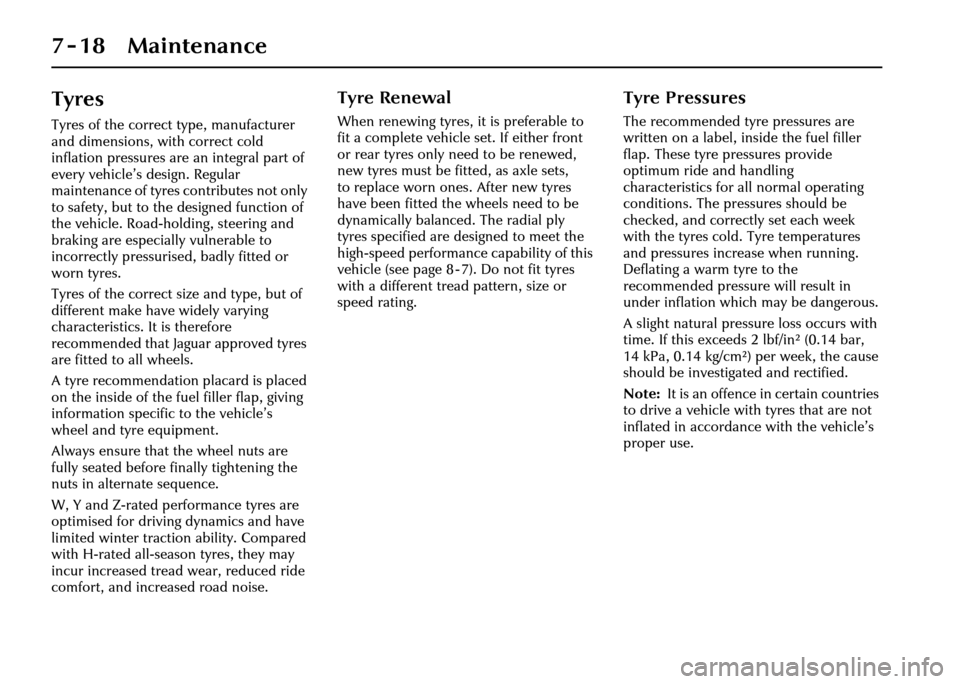
7-18 Maintenance
Tyres
Tyres of the correct type, manufacturer
and dimensions, with correct cold
inflation pressures are an integral part of
every vehicle’s design. Regular
maintenance of tyres contributes not only
to safety, but to the de signed function of
the vehicle. Road-holding, steering and
braking are especially vulnerable to
incorrectly pressurised, badly fitted or
worn tyres.
Tyres of the correct size and type, but of
different make have widely varying
characteristics. It is therefore
recommended that Jaguar approved tyres
are fitted to all wheels.
A tyre recommendation placard is placed
on the inside of the fuel filler flap, giving
information specific to the vehicle’s
wheel and tyre equipment.
Always ensure that the wheel nuts are
fully seated before finally tightening the
nuts in alternate sequence.
W, Y and Z-rated performance tyres are
optimised for driving dynamics and have
limited winter traction ability. Compared
with H-rated all-season tyres, they may
incur increased tread wear, reduced ride
comfort, and increased road noise.
Tyre Renewal
When renewing tyres, it is preferable to
fit a complete vehicle set. If either front
or rear tyres only need to be renewed,
new tyres must be fitted, as axle sets,
to replace worn ones. After new tyres
have been fitted the wheels need to be
dynamically balanced. The radial ply
tyres specified are designed to meet the
high-speed performance capability of this
vehicle (see page 8 - 7) . Do not fit tyres
with a different tread pattern, size or
speed rating.
Tyre Pressures
The recommended tyre pressures are
written on a label, inside the fuel filler
flap. These tyre pressures provide
optimum ride and handling
characteristics for all normal operating
conditions. The pressures should be
checked, and correctly set each week
with the tyres cold. Tyre temperatures
and pressures increase when running.
Deflating a warm tyre to the
recommended pressure will result in
under inflation whic h may be dangerous.
A slight natural pressure loss occurs with
time. If this exceeds 2 lbf/in² (0.14 bar,
14 kPa, 0.14 kg/cm²) per week, the cause
should be investigated and rectified.
Note: It is an offence in certain countries
to drive a vehicle with tyres that are not
inflated in accordance with the vehicle’s
proper use.
Page 202 of 227

Maintenance 7 - 19
Wear
All tyres fitted as original equipment
include tread wear indicators (TWI) in
their tread pattern. When the tread has
worn to a remaining depth of 1.6 mm the
indicators appear at the surface as bars
which connect the tread pattern across
the full width of the tyre.
It is illegal, in certain countries,
to continue to use tyres after the tread
has worn to less than 1.6 mm over three
quarters of the width and the entire
circumference of the tyre.It should be noted that the properties of
many tyres alter progressively with wear.
In particular the ‘wet grip’ and
aquaplaning resistance are gradually but
substantially reduce
d. Extra care and
speed restriction should therefore be
exercised on wet roads as the effective
tread depth diminishes.
Incorrect wheel alignm ent will accelerate
tyre wear. Fins on the inner or outer
edges of the tread pattern are caused by
excessive toe-in or toe-out respectively.
As fins may also be caused by high
cornering speeds or road camber, it is
advantageous to have the cause detected
by having the wheel alignment checked.
Tyre repair
It is recommended that damaged tyres
are discarded and new tyres fitted.
They must not be repaired in view of the
high performance capability of the
vehicle. Damage
Excessive local distortion can cause the
casing of a tyre to
fracture and may lead
to premature failure. Tyres should be
examined especially for cracked walls,
exposed cords, etc. Flints and other sharp
objects must be removed from the tyre
tread; if left in they may work through the
cover. Clean off any oil or grease
contamination by using a suitable
cleaner.
Caution: Do not use paraffin
(kerosene), because this has a
detrimental effect on rubber.
Tyre use after vehicle storage
After a long period of a vehicle standing,
tyres may become locally distorted with a
flat area. This will cause an uneven ride
for a few miles until the tyres have
warmed up and the ‘flat’ rounds off.
However, to reduce the effects of
flat-spots, the tyres of a stored vehicle
may be inflated to pressures not
exceeding 60 lbf/in² (4.2 bar, 420 kPa,
4.3 kg/cm²).
Page 203 of 227
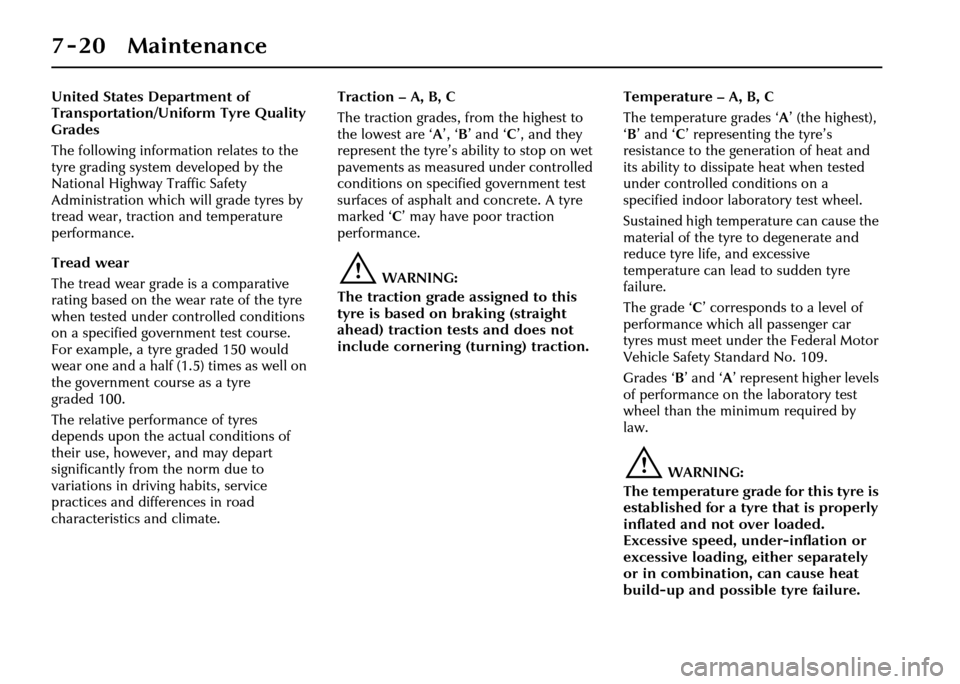
7-20 Maintenance
United States Department of
Transportation/Uniform Tyre Quality
Grades
The following information relates to the
tyre grading system developed by the
National Highway Traffic Safety
Administration which will grade tyres by
tread wear, traction and temperature
performance.
Tread wear
The tread wear grade is a comparative
rating based on the wear rate of the tyre
when tested under controlled conditions
on a specified government test course.
For example, a tyre graded 150 would
wear one and a half (1.5) times as well on
the government course as a tyre
graded 100.
The relative performance of tyres
depends upon the actual conditions of
their use, however, and may depart
significantly from the norm due to
variations in driving habits, service
practices and differences in road
characteristics and climate. Traction – A, B, C
The traction grades, from the highest to
the lowest are ‘
A’, ‘ B’ and ‘ C’, and they
represent the tyre’s ability to stop on wet
pavements as measured under controlled
conditions on specified government test
surfaces of asphalt and concrete. A tyre
marked ‘ C’ may have poor traction
performance.
!WARNING:
The traction grade assigned to this
tyre is based on braking (straight
ahead) traction tests and does not
include cornering (turning) traction. Temperature – A, B, C
The temperature grades ‘
A’ (the highest),
‘ B ’ and ‘C ’ representing the tyre’s
resistance to the generation of heat and
its ability to dissipate heat when tested
under controlled conditions on a
specified indoor laboratory test wheel.
Sustained high temperature can cause the
material of the tyre to degenerate and
reduce tyre life, and excessive
temperature can lead to sudden tyre
failure.
The grade ‘ C’ corresponds to a level of
performance which all passenger car
tyres must meet under the Federal Motor
Vehicle Safety Standard No. 109.
Grades ‘ B’ and ‘ A’ represent higher levels
of performance on the laboratory test
wheel than the minimum required by
law.
!WARNING:
The temperature grade for this tyre is
established for a tyre that is properly
inflated and not over loaded.
Excessive speed, under-inflation or
excessive loading, either separately
or in combination, can cause heat
build-up and possible tyre failure.
Page 204 of 227
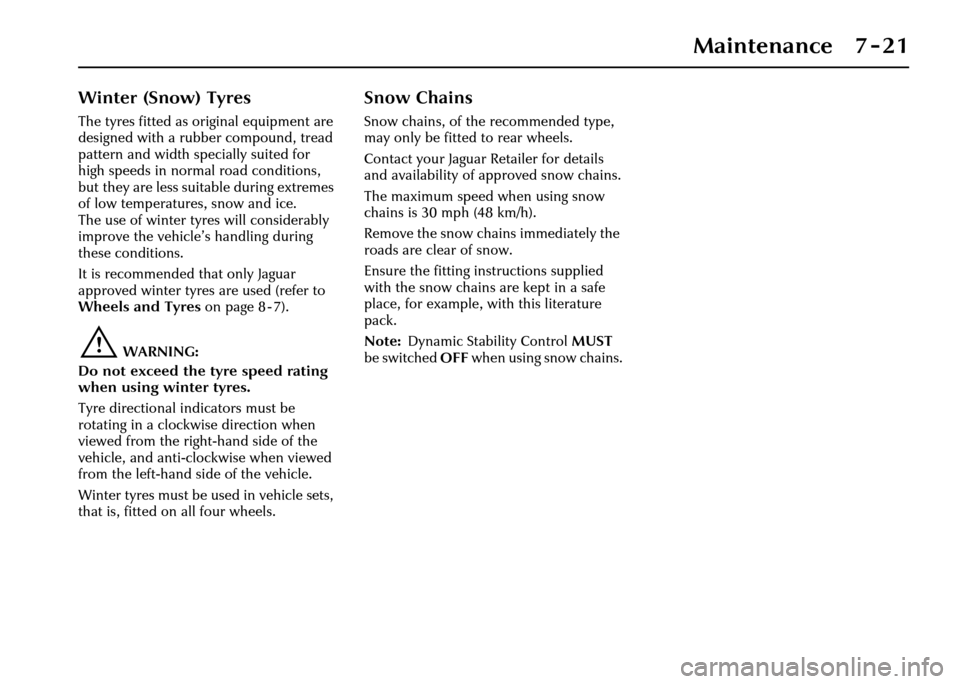
Maintenance 7 - 21
Winter (Snow) Tyres
The tyres fitted as original equipment are
designed with a rubber compound, tread
pattern and width specially suited for
high speeds in normal road conditions,
but they are less suitable during extremes
of low temperatures, snow and ice.
The use of winter tyres will considerably
improve the vehicle’s handling during
these conditions.
It is recommended that only Jaguar
approved winter tyres are used (refer to
Wheels and Tyres on page 8 - 7).
!WARNING:
Do not exceed the tyre speed rating
when using winter tyres.
Tyre directional indicators must be
rotating in a clockwise direction when
viewed from the right-hand side of the
vehicle, and anti-clockwise when viewed
from the left-hand side of the vehicle.
Winter tyres must be used in vehicle sets,
that is, fitted on all four wheels.
Snow Chains
Snow chains, of the recommended type,
may only be fitted to rear wheels.
Contact your Jaguar Retailer for details
and availability of approved snow chains.
The maximum speed when using snow
chains is 30 mph (48 km/h).
Remove the snow chains immediately the
roads are clear of snow.
Ensure the fitting instructions supplied
with the snow chains are kept in a safe
place, for example, wi th this literature
pack.
Note: Dynamic Stability Control MUST
be switched OFF when using snow chains.
Page 205 of 227
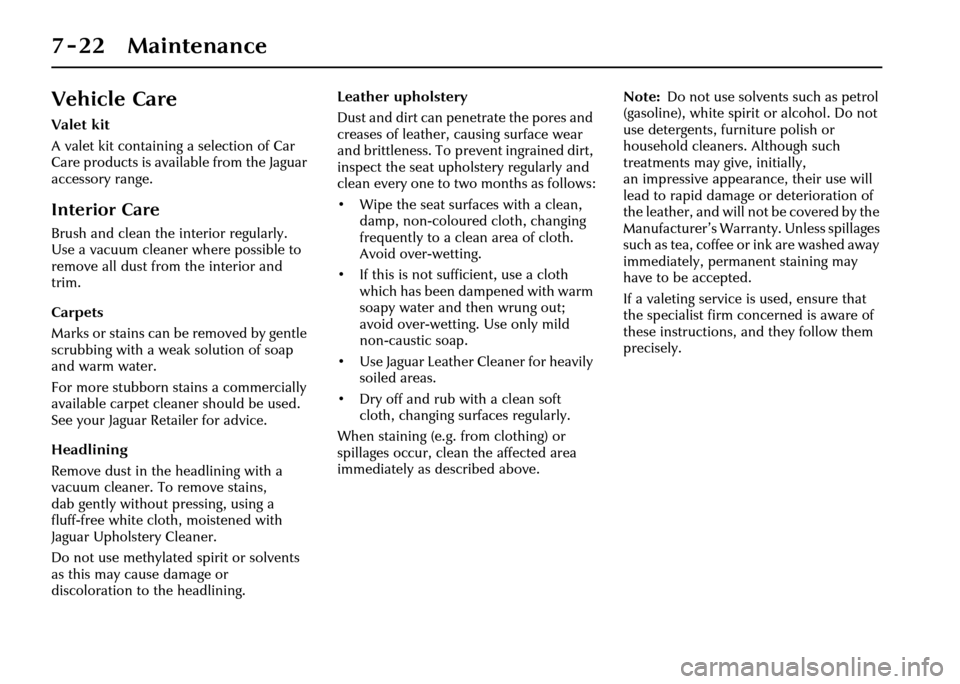
7-22 Maintenance
Vehicle Care
Valet kit
A valet kit containing a selection of Car
Care products is available from the Jaguar
accessory range.
Interior Care
Brush and clean the interior regularly.
Use a vacuum cleaner where possible to
remove all dust from the interior and
trim.
Carpets
Marks or stains can be removed by gentle
scrubbing with a weak solution of soap
and warm water.
For more stubborn stains a commercially
available carpet cleaner should be used.
See your Jaguar Retailer for advice.
Headlining
Remove dust in the headlining with a
vacuum cleaner. To remove stains,
dab gently without pressing, using a
fluff-free white cloth, moistened with
Jaguar Upholstery Cleaner.
Do not use methylated spirit or solvents
as this may cause damage or
discoloration to the headlining.Leather upholstery
Dust and dirt can penetrate the pores and
creases of leather, causing surface wear
and brittleness. To prevent ingrained dirt,
inspect the seat upholstery regularly and
clean every one to two months as follows:
• Wipe the seat surfaces with a clean,
damp, non-coloured cloth, changing
frequently to a clean area of cloth.
Avoid over-wetting.
• If this is not sufficient, use a cloth which has been dampened with warm
soapy water and then wrung out;
avoid over-wetting. Use only mild
non-caustic soap.
• Use Jaguar Leather Cleaner for heavily soiled areas.
• Dry off and rub with a clean soft cloth, changing su rfaces regularly.
When staining (e.g. from clothing) or
spillages occur, clean the affected area
immediately as described above. Note:
Do not use solvents such as petrol
(gasoline), white spirit or alcohol. Do not
use detergents, furniture polish or
household cleaners. Although such
treatments may give, initially,
an impressive appearance, their use will
lead to rapid damage or deterioration of
the leather, and will not be covered by the
Manufacturer’s Warranty. Unless spillages
such as tea, coffee or ink are washed away
immediately, permanent staining may
have to be accepted.
If a valeting service is used, ensure that
the specialist firm concerned is aware of
these instructions, and they follow them
precisely.
Page 206 of 227
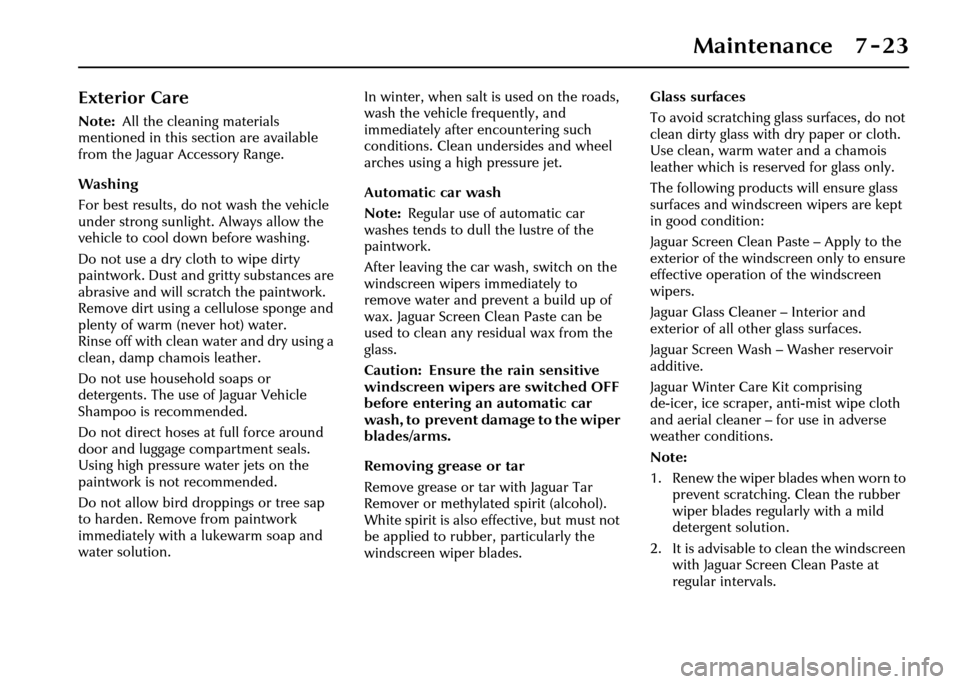
Maintenance 7 - 23
Exterior Care
Note:All the cleaning materials
mentioned in this section are available
from the Jaguar Accessory Range.
Washing
For best results, do not wash the vehicle
under strong sunlight. Always allow the
vehicle to cool down before washing.
Do not use a dry cloth to wipe dirty
paintwork. Dust and gr itty substances are
abrasive and will scratch the paintwork.
Remove dirt using a cellulose sponge and
plenty of warm (never hot) water.
Rinse off with clean water and dry using a
clean, damp chamois leather.
Do not use household soaps or
detergents. The use of Jaguar Vehicle
Shampoo is recommended.
Do not direct hoses at full force around
door and luggage compartment seals.
Using high pressure water jets on the
paintwork is not recommended.
Do not allow bird droppings or tree sap
to harden. Remove from paintwork
immediately with a lukewarm soap and
water solution. In winter, when salt is used on the roads,
wash the vehicle frequently, and
immediately after encountering such
conditions. Clean undersides and wheel
arches using a high pressure jet.
Automatic car wash
Note:
Regular use of automatic car
washes tends to dull the lustre of the
paintwork.
After leaving the car wash, switch on the
windscreen wipers immediately to
remove water and prev ent a build up of
wax. Jaguar Screen Clean Paste can be
used to clean any residual wax from the
glass.
Caution: Ensure the rain sensitive
windscreen wipers are switched OFF
before entering an automatic car
wash, to prevent damage to the wiper
blades/arms.
Removing grease or tar
Remove grease or tar with Jaguar Tar
Remover or methylated spirit (alcohol).
White spirit is also effective, but must not
be applied to rubber, particularly the
windscreen wiper blades. Glass surfaces
To avoid scratching glass surfaces, do not
clean dirty glass with
dry paper or cloth.
Use clean, warm water and a chamois
leather which is reserved for glass only.
The following products will ensure glass
surfaces and windscreen wipers are kept
in good condition:
Jaguar Screen Clean Paste – Apply to the
exterior of the windscreen only to ensure
effective operation of the windscreen
wipers.
Jaguar Glass Cleaner – Interior and
exterior of all other glass surfaces.
Jaguar Screen Wash – Washer reservoir
additive.
Jaguar Winter Care Kit comprising
de-icer, ice scraper, anti-mist wipe cloth
and aerial cleaner – for use in adverse
weather conditions.
Note:
1. Renew the wiper blades when worn to prevent scratching. Clean the rubber
wiper blades regularly with a mild
detergent solution.
2. It is advisable to clean the windscreen with Jaguar Screen Clean Paste at
regular intervals.
Page 207 of 227
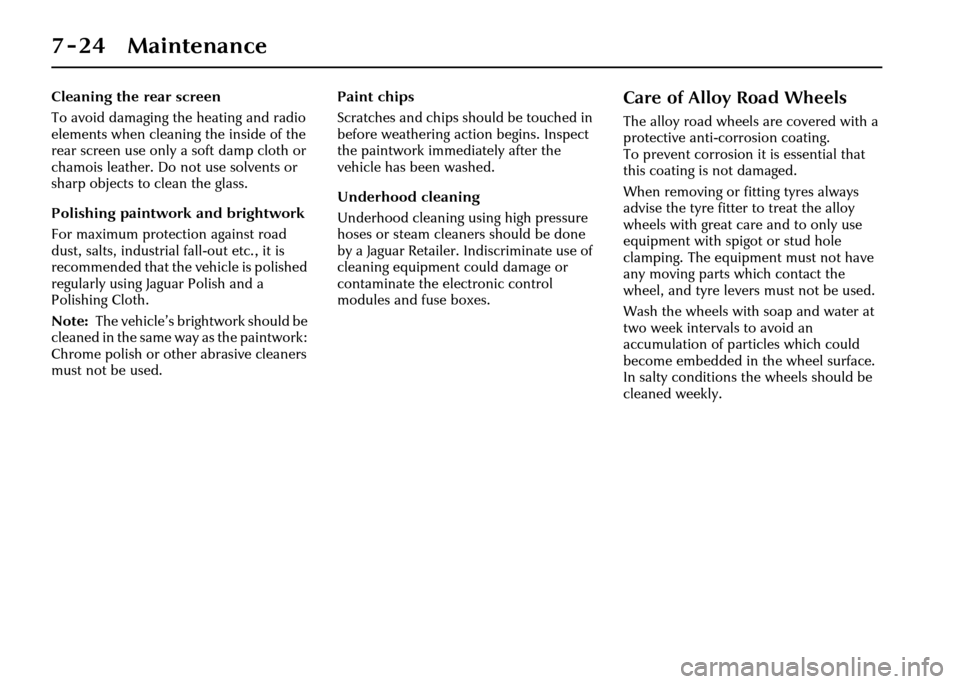
7-24 Maintenance
Cleaning the rear screen
To avoid damaging the heating and radio
elements when cleaning the inside of the
rear screen use only a soft damp cloth or
chamois leather. Do not use solvents or
sharp objects to clean the glass.
Polishing paintwork and brightwork
For maximum protection against road
dust, salts, industrial fall-out etc., it is
recommended that the vehicle is polished
regularly using Jaguar Polish and a
Polishing Cloth.
Note:The vehicle’s brightwork should be
cleaned in the same way as the paintwork:
Chrome polish or other abrasive cleaners
must not be used. Paint chips
Scratches and chips should be touched in
before weathering action begins. Inspect
the paintwork imme
diately after the
vehicle has been washed.
Underhood cleaning
Underhood cleaning using high pressure
hoses or steam cleaners should be done
by a Jaguar Retailer. Indiscriminate use of
cleaning equipment could damage or
contaminate the electronic control
modules and fuse boxes.Care of Alloy Road Wheels
The alloy road wheels are covered with a
protective anti-corrosion coating.
To prevent corrosion it is essential that
this coating is not damaged.
When removing or fitting tyres always
advise the tyre fitte r to treat the alloy
wheels with great care and to only use
equipment with spigot or stud hole
clamping. The equipment must not have
any moving parts which contact the
wheel, and tyre levers must not be used.
Wash the wheels with soap and water at
two week intervals to avoid an
accumulation of particles which could
become embedded in the wheel surface.
In salty conditions the wheels should be
cleaned weekly.
Page 208 of 227
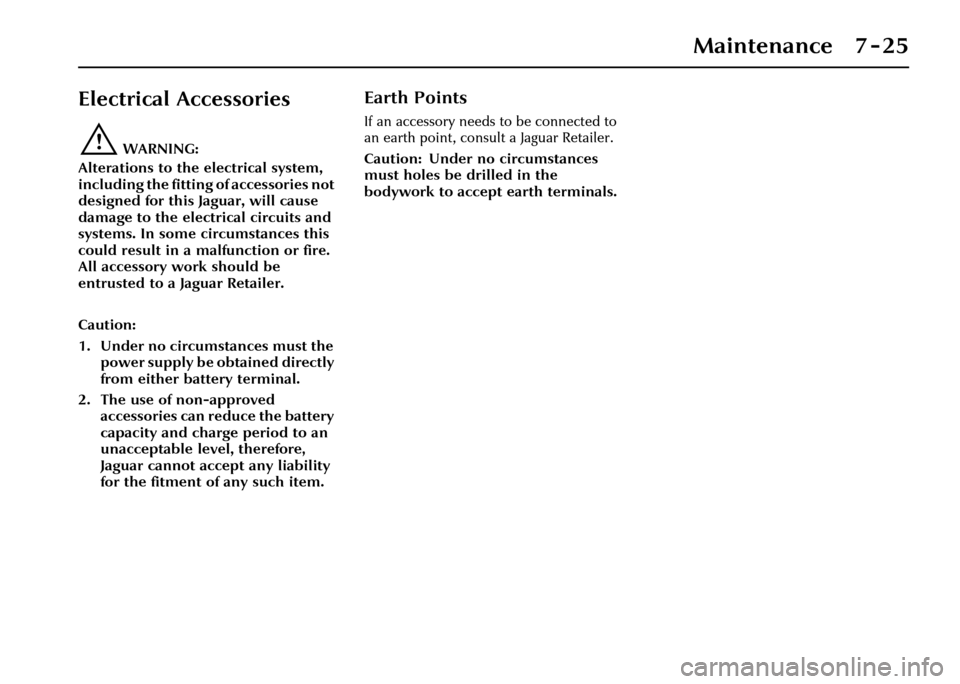
Maintenance 7 - 25
Electrical Accessories
!WARNING:
Alterations to the electrical system,
including the fitting of accessories not
designed for this Jaguar, will cause
damage to the electrical circuits and
systems. In some circumstances this
could result in a malfunction or fire.
All accessory work should be
entrusted to a Jaguar Retailer.
Caution:
1. Under no circumstances must the power supply be obtained directly
from either battery terminal.
2. The use of non-approved accessories can reduce the battery
capacity and charge period to an
unacceptable level, therefore,
Jaguar cannot acce pt any liability
for the fitment of any such item.
Earth Points
If an accessory needs to be connected to
an earth point, consult a Jaguar Retailer.
Caution: Under no circumstances
must holes be drilled in the
bodywork to accept earth terminals.
Page 209 of 227
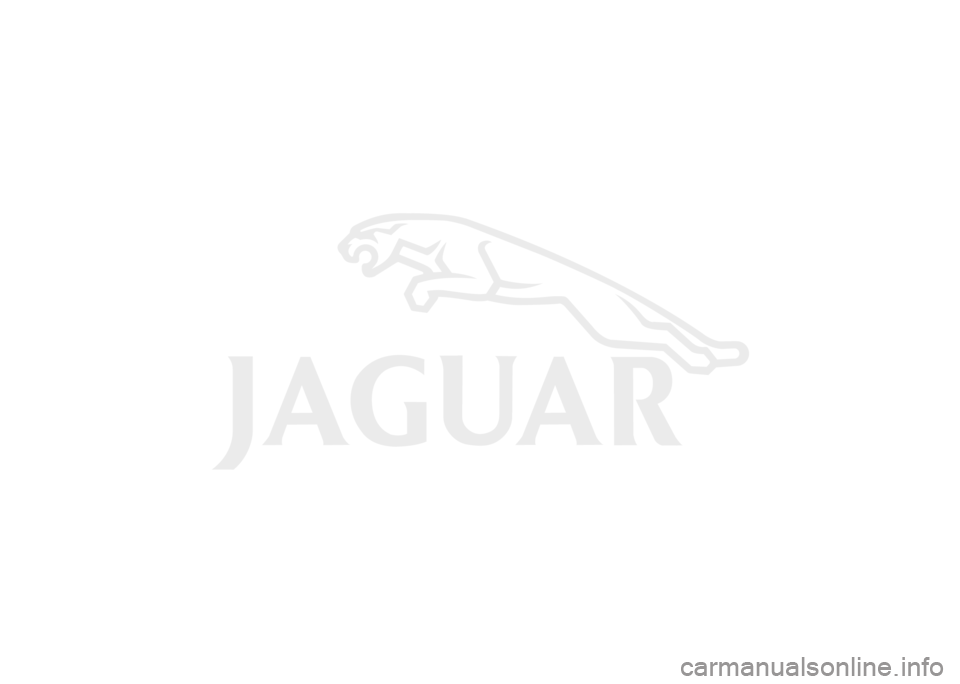
Page 210 of 227
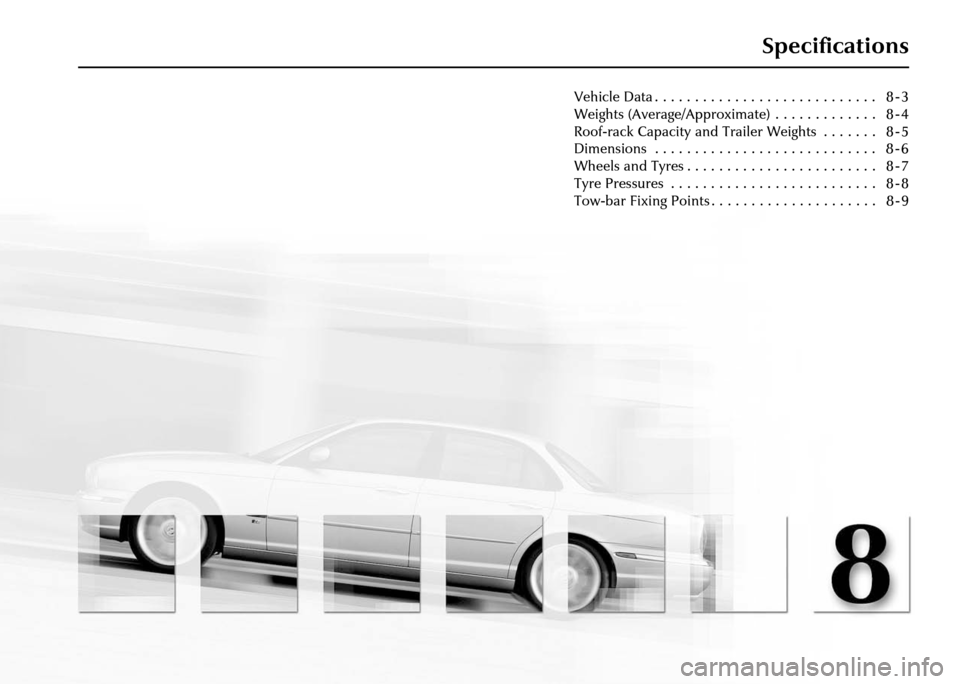
Specifications
Vehicle Data . . . . . . . . . . . . . . . . . . . . . . . . . . . . 8 - 3
Weights (Average/Approximate) . . . . . . . . . . . . . 8 - 4
Roof-rack Capacity and Trailer Weights . . . . . . . 8 - 5
Dimensions . . . . . . . . . . . . . . . . . . . . . . . . . . . . 8 - 6
Wheels and Tyres . . . . . . . . . . . . . . . . . . . . . . . . 8 - 7
Tyre Pressures . . . . . . . . . . . . . . . . . . . . . . . . . . 8 - 8
Tow-bar Fixing Points . . . . . . . . . . . . . . . . . . . . . 8 - 9